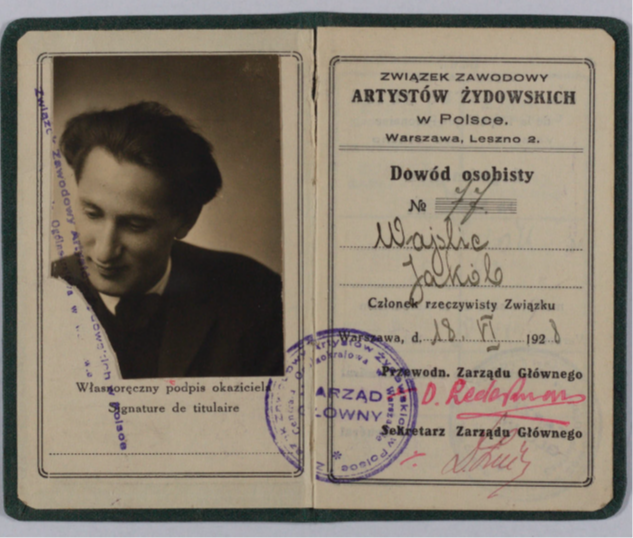click to dowload our latest edition
CLICK HERE TO SUBSCRIBE TO OUR NEWSLETTER


Published
2 years agoon
As an archivist at the National Library of Lithuania was opening boxes to show off some recent discoveries, she pulled out a Yiddish theatre poster to the amazement of visitors there.
“That’s my principal from Melbourne, Jacob Waislitz!” exclaimed Australian visitors to Lithuania, Irene Kronhill and her friend Onella Stagol.
Kronhill and Stagol were on a Yivo Study Trip to Poland and Lithuania two summers ago. Founded in 1925, the goal of Yivo, the Institute for Jewish Research, is to preserve, study, share, and perpetuate knowledge of the history and culture of Eastern European Jewry.
They were both stunned to be so suddenly connected to their own past by the poster. Waislitz, a world-renowned Yiddish actor and director, had been the principal of the Yiddish school they attended on Wednesdays and Sundays during their childhood in Melbourne.
“We went there after school,” Kronhill told the SA Jewish Report. “We learnt Yiddish, literature, and history there.”
Some of the newly discovered material they saw in the library back then are now being digitised as part of the Edward Blank Yivo Vilna Collections Project.
This project comprises about 4.1 million pages of original books, artefacts, records, manuscripts, and documents. It’s the first of its kind in Jewish history, and is the single largest digital collection related to East European Jewish civilisation.
It forms part of an historic seven-year, $7 million (R106.4 million) initiative to process, conserve, and digitise the New York-based Yivo Institute for Jewish Research’s divided pre-war library and archival collections.
Material has been digitised into a dedicated web portal and is now accessible worldwide. The Edward Blank Yivo Vilna Online Collection was completed on 10 January.
Many of the documents were destroyed in 1941 when the original Yivo Institute in Vilna was ransacked. However, a group of Vilna ghetto workers (many of whom had been associated with Yivo) were forced to sort through the collections and select material to be shipped to Frankfurt for use in the Nazi Institute for the Study of the Jewish Question.
However, many of these ghetto workers, commonly known as the Paper Brigade, risked their lives by hiding material on their bodies to smuggle into the Vilna ghetto to preserve it.
In 1946, the United States Army recovered many of these documents and sent them to Yivo in New York. Then, the smuggled material was uncovered after the war and saved from the Soviets by Lithuanian librarian Antanas Ulpis in 1948. These remained hidden in the Church of St George (converted by the Soviets into the Lithuanian Book Chamber) until they were discovered in 1989.
In the Yivo archives, Kronhill also found a photograph of a protest march conducted by a youth movement from the 1930s. “I recognised a woman in the front because she was the mother of someone who I had gone to the youth movement with.”
A former United States ambassador to the United Nations Commission on the Status of Women, Meryl Frank, also uncovered much in the Yivo archives. She discovered the facts behind the stories she had heard about her actress cousin, Franya Winter, and her cousin’s lover, Rudolf Zaslavsky, also an actor.
“I was stunned by the volume of information I was able to find,” she says. “I found that the stories told by my family weren’t exaggerated as I had earlier thought.”
Frank is writing a book about Winter, who played the role of Tzeitel in Tevye the Milkman. She had heard about Yivo’s archives while attending a Yivo class on the history of Yiddish theatre.
“Stephanie Halpern, the director of archives at Yivo, brought to our class artefacts from the Yivo collection including theatrical posters, one which featured Rudolf Zaslavsky,” Frank said. “I was told about the volume of theatrical artefacts and papers that it had, and was delighted to find information about my cousin that had been hidden by the Paper Brigade beneath the Vilna Ghetto and rescued by the Monuments Men [the art detectives of World War II] in Germany.
“All archives are special places, but these papers are particularly precious because they were meant to be destroyed, just as those who wrote them ultimately were,” Frank says.
Before using Yivo’s archives, Dr David Crossley, based in the United Kingdom, had just a vague idea about his paternal grandmother’s cousin, Nachum Lipovsky (1874-1928).
Lipovsky, the founder and first director of the Vilna Yiddish Theatre, has now been brought to life through his compendium of correspondence in the archives.
“Yivo has compiled Nachum’s collection, which comprises various hand-written manuscripts of plays and ephemera, mainly in Yiddish, which my sister has tried to decipher,” says Crossley. “Even her expertise in speaking and writing in Yiddish cannot do justice to reading or even understanding his written words.”
With a deeper reading of Lipovsky’s work needed, Crossley has printed out the archives so his future family can engross themselves in “translating their relatively famous predecessor’s works and gain pleasure in being associated in the rebirth of Yiddish as a still extant language of life and culture”.
Crossley cannot praise Yivo highly enough. “My experience of the archivists and researchers has been extremely friendly and responsive,” he says.
Dr Samuel Kassow, whose book Who Will Write Our History was adapted into a documentary film, has used the archives to find material on cultural life in Vilna between the two world wars.
